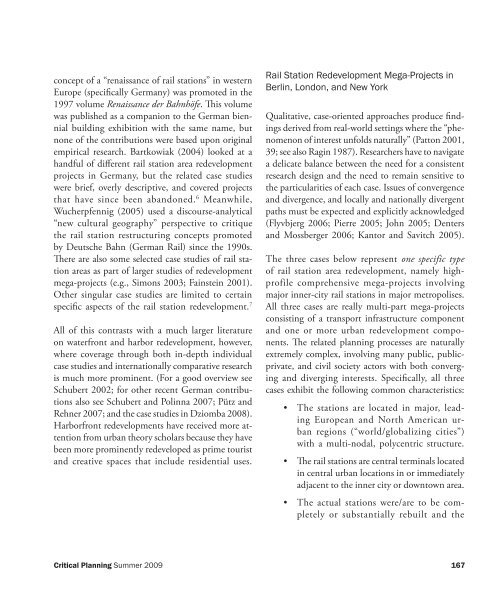162 Critical Planning Summer 2006 Critical Planning Summer 2009 ...
162 Critical Planning Summer 2006 Critical Planning Summer 2009 ...
162 Critical Planning Summer 2006 Critical Planning Summer 2009 ...
Create successful ePaper yourself
Turn your PDF publications into a flip-book with our unique Google optimized e-Paper software.
concept of a “renaissance of rail stations” in western<br />
Europe (specifically Germany) was promoted in the<br />
1997 volume Renaissance der Bahnhöfe. This volume<br />
was published as a companion to the German biennial<br />
building exhibition with the same name, but<br />
none of the contributions were based upon original<br />
empirical research. Bartkowiak (2004) looked at a<br />
handful of different rail station area redevelopment<br />
projects in Germany, but the related case studies<br />
were brief, overly descriptive, and covered projects<br />
that have since been abandoned. 6 Meanwhile,<br />
Wucherpfennig (2005) used a discourse-analytical<br />
“new cultural geography” perspective to critique<br />
the rail station restructuring concepts promoted<br />
by Deutsche Bahn (German Rail) since the 1990s.<br />
There are also some selected case studies of rail station<br />
areas as part of larger studies of redevelopment<br />
mega-projects (e.g., Simons 2003; Fainstein 2001).<br />
Other singular case studies are limited to certain<br />
specific aspects of the rail station redevelopment. 7<br />
All of this contrasts with a much larger literature<br />
on waterfront and harbor redevelopment, however,<br />
where coverage through both in-depth individual<br />
case studies and internationally comparative research<br />
is much more prominent. (For a good overview see<br />
Schubert 2002; for other recent German contributions<br />
also see Schubert and Polinna 2007; Pütz and<br />
Rehner 2007; and the case studies in Dziomba 2008).<br />
Harborfront redevelopments have received more attention<br />
from urban theory scholars because they have<br />
been more prominently redeveloped as prime tourist<br />
and creative spaces that include residential uses.<br />
Rail Station Redevelopment Mega-Projects in<br />
Berlin, London, and New York<br />
Qualitative, case-oriented approaches produce findings<br />
derived from real-world settings where the “phenomenon<br />
of interest unfolds naturally” (Patton 2001,<br />
39; see also Ragin 1987). Researchers have to navigate<br />
a delicate balance between the need for a consistent<br />
research design and the need to remain sensitive to<br />
the particularities of each case. Issues of convergence<br />
and divergence, and locally and nationally divergent<br />
paths must be expected and explicitly acknowledged<br />
(Flyvbjerg <strong>2006</strong>; Pierre 2005; John 2005; Denters<br />
and Mossberger <strong>2006</strong>; Kantor and Savitch 2005).<br />
The three cases below represent one specific type<br />
of rail station area redevelopment, namely highprofile<br />
comprehensive mega-projects involving<br />
major inner-city rail stations in major metropolises.<br />
All three cases are really multi-part mega-projects<br />
consisting of a transport infrastructure component<br />
and one or more urban redevelopment components.<br />
The related planning processes are naturally<br />
extremely complex, involving many public, publicprivate,<br />
and civil society actors with both converging<br />
and diverging interests. Specifically, all three<br />
cases exhibit the following common characteristics:<br />
• The stations are located in major, leading<br />
European and North American urban<br />
regions (“world/globalizing cities”)<br />
with a multi-nodal, polycentric structure.<br />
• The rail stations are central terminals located<br />
in central urban locations in or immediately<br />
adjacent to the inner city or downtown area.<br />
• The actual stations were/are to be completely<br />
or substantially rebuilt and the<br />
<strong>Critical</strong> <strong>Planning</strong> <strong>Summer</strong> <strong>2009</strong> 167

















